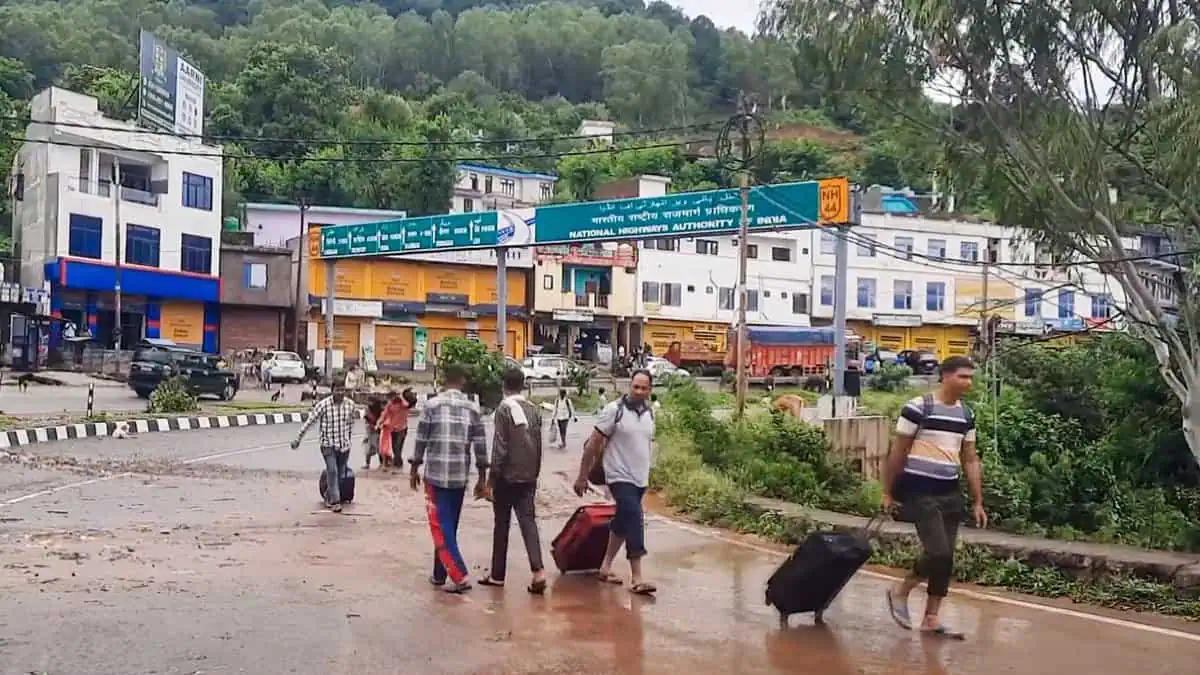
Jammu: The Jammu-Srinagar national highway was closed for traffic for the third consecutive day on Thursday due to multiple landslides triggered by heavy rains in the Udhampur-Ramban belt, officials said.
Due to the closure of the highway, over 500 to 600 vehicles are stranded at various places en route.
The 270-km-long stretch, the only all-weather road linking Kashmir with the rest of the country, was blocked by multiple landslides at several places between Jakheni and Chenani in Udhampur, they said.
“Highway is closed for vehicular movement from Jakheni in Udhampur towards Srinagar due to damage at several places between Jakheni and Chenani. No vehicular movement shall be allowed from Nagrota in Jammu towards Reasi, Chenani, Patnitop, Doda, Ramban, Banihal, Srinagar,” a traffic police official said.
He said commuters belonging to Katra and Udhampur towns are requested to keep their photo ID cards to prove their identity so that their movement can be facilitated smoothly.
The men and machines of the Border Roads Organisation (BRO) are working to clear the highway of blockades, which occurred on Tuesday following heavy rains and flash floods, they said.
According to the traffic advisory, the Kishtwar-Sinthan-Anantnag highway is closed for vehicular movement.
It said subject to fair weather and good road condition, and after getting a green signal from the BRO, traffic movement shall be allowed in a regulated manner on the Srinagar-Sonamarg-Gumari road.
LMVs followed by HMVs shall be allowed from Sonamarg towards Kargil between 1130 hours and 1730 hours.
“No vehicle shall be allowed after the cut-off timing. Security forces convoys plying from Srinagar to Kargil and vice versa shall plan their movement in such a manner so that civil traffic is not disturbed,” the advisory said.
According to the advisory, movement of LMVs shall be allowed on Mughal Road between Shopian district of Kashmir and Poonch district of Jammu region, subject to fair weather and good road condition, after getting a green signal from road maintenance agencies.
“LMVs and private cars shall be allowed from both sides on Mughal Road, i.e., from Jammu towards Srinagar and vice versa via Poonch. These vehicles shall be allowed from Behramgala in Poonch and Herpora in Shopian between 0700 hours and 1800 hours,” it said.
Jammu witnesses highest ever rainfall
Jammu and Kashmir witnessed unprecedented monsoon onslaught, with Jammu logging 380 mm of rainfall in 24 hours ending 8.30 am on Wednesday, the highest ever recorded in the city since 1910 when the observatory was set up.
Similarly, Udhampur received the highest recorded rainfall of 630 mm for the same 24-hour period, surpassing the earlier highest of 342 mm on July 31, 2019, a spokesperson of the Meteorological department said.
Jammu got its first observatory in 1910 and the highest record for a 24-hour period was 272.6 mm experienced on August 9, 1973. Earlier, the city had recorded the highest 24-hour rainfall of 228.6 mm nearly a century ago on August 5, 1926.
Incidentally, the average rainfall in Jammu and Udhampur for the month of August is 403.1 mm and 418 mm, respectively.
Katra, the base camp for the pilgrims visiting Mata Vaishno Devi Shrine in Reasi district, also recorded a 24-hour rainfall of 284 mm followed by 183.4 mm (Bhaderwah) and 85.4 (Kokernag) and 83.2 (Qazigund) in south Kashmir.
Swollen by record-breaking rain, river Tawi inundated hundreds of homes and hectares of farmland, washed away structures and livestock, and displaced over 6,000 people, all within a day.
By Tuesday dawn, the calm river had turned into a raging torrent, submerging low-lying localities, particularly riverbank colonies of Peerkho, Gujjar Nagar, Gurkha Nagar and others. Streets became waterways, prompting large-scale rescue operations amid panic across the ‘city of temples.’
“We have never seen Tawi in such a furious and devastating mood. A calm river was roaring like a lion, and people feared it would breach its banks and bury the city,” said Shivanand, a priest at a Shiv temple near the river.
Peerkho, among the worst-hit areas, was left strewn with half-buried vehicles, debris, boulders and uprooted trees. More than 300 people, including children clinging to their mothers and the elderly too frail to walk, were pulled out in desperate rescue operations. But fear still lingered.
Officials said 5,000–6,000 people were evacuated from 17 locations by the army, NDRF, SDRF, police and locals. For the first time, NDRF used boats in Jammu city to rescue the stranded.
Officials estimate that 2,000–3,000 houses and several commercial establishments have been submerged in dozens of localities, while livestock losses are also extensive.
As many as 41 people lost their lives and scores of others were injured in rain-related incidents since Tuesday across Jammu division. The dead included 34 pilgrims who lost their lives in a landslide en route to Mata Vaishno Devi shrine.
(With inputs from agencies)



